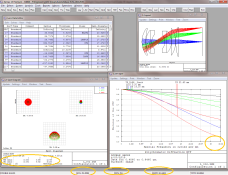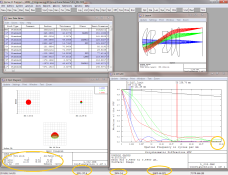I have some free time now that I'm on lunch break, so I decided to set up a model in ZEMAX to maybe better show how aberrations scale.
One comment before I begin: ZEMAX is sort of the de-facto industry standard optical design program, used by the great majority of optical designers (and non-optical designers) in the world today.. and has been that way for the past 10 years at least. So it's a fair bet that any modern camera lens designed over the past decade was designed using ZEMAX (and the experience of the designer as well). One well-known example that I'm aware of is that the '03 Mars Rover optics were designed in ZEMAX by Greg H. Smith. He wrote a white paper available in the public domain:
http://lkellogg.vttoth.com/LarryRussellKellogg/SPIE_paper.pdf Just in case you are wondering how accurate a design program can be... it is good enough to send optics to another planet!
I use a basic 50mm f/1.8 Double Gauss design to demonstrate the principle, but I'll stop it down to f/5.6 since practical large format lenses start at that f/#. I think this design is actually the Olympus OM-series 50mm f/1.8 patent prescription, if you're curious where it came from, but it is one of the designs in Zemax's (and Code V too I think) optical database.
The first output shows the prescription, layout, geometric spot diagram, and the MTF up to 33 lp/mm. Hopefully it's high enough resolution to read when I upload it, but if not PM me and I can email you the original. Note the effective focal length (EFFL), f/# (ISFN), and the entrance pupil diameter (ENPD) shown at bottom. 51.21 mm / 5.6 = 9.144 mm.
The spot diagram indicates the blur size you'd get if you imaged a point source such as a star. The colored lines on the MTF plot correspond to the field angles shown in the layout. Both are used as metrics for optical design performance, along with ray fans and OPD plots. Blue = center, green 14 mm off-center (on the film), and red = 21.6 mm off center (about the corner of the film).
Now I scale up the design to "fit" an 8x10 format. For fair comparison, I want to keep the same aspect ratio, so I scale for a 6.85" x 10" film plane. So I have to scale the lens to a focal length of 51.21 * (254/35) = 371.6 mm. This gives the same FOV for both lenses. The scaling factor is about 7.25.
Here's the scaled design. Note the f/# remains the same (the aperture scaled: f/# = focal length / aperture diameter).
Pay attention to the values circled... particularly the GEO radius (geometric radius) in the spot diagram. The spot radius values scaled by the same 7.25 factor. Also look at the MTF.
Now if you enlarge and make a print from the 35mm film by 7.25x, then compare to a contact print from the larger format, the blurs will all look the same... the only difference is from the effect of the film grain itself (assuming you did all the development the same of course).
Aberrations scale with focal length (for same f/#).







